Venus-Saturn Conjunction - June 30, 2007
This was taken from the DAO
Telescope: Orion 100 ED, f9 refractor on an HEQ5 mount
Camera: Nikon D80
Guy Walton |
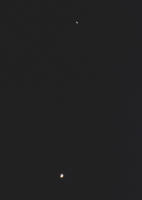 |
Jupiter - June 30, 2007
Jupiter was fantastic last night. I've been more than a little disappointed
with it so far this year. Last night I felt it was worthy of sketching. I
really liked those stretched out white bands within the Northern Equatorial
zone. I did the sketch as B&W then inverted the background. I also included
its moons because I liked the arrangement. This is a Newtonian view.
Bill Weir |
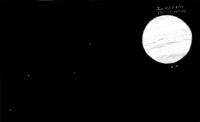 |
61 Cyg AB - June 29, 2007
Yesterday I took several image of 61 Cyg AB and I was trying to get the same
result than with Albireo... getting great colour from the DSI. After an hour
and a lot of images ready to be stack, this is the result... really
frustrating. Charles was right about the learning curve could be hard with
that kind of equipment. I'm still learning apparently
Michel Michaud |
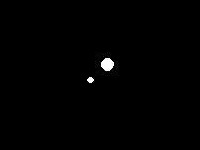 |
| Jupiter & Venus-Saturn Conjunction - June 29, 2007
At one point when I was looking to the east and watching the Moon rise I
noticed the other gas giant blazing away so I swung my Dob around to have a
quick look. The arrangement of it's moons was quite unusual. So I fired off
a few shots with the point and shoot held up to a 12mm eyepiece. I'm
presenting my best lie of that. (Don't ask how I processed it because I
don't remember and I don't really know what I'm doing)
The second image was taken just as I turned off of Rocky Point Road. Venus
and Saturn setting into the hillside with the trees and the house in the
foreground inspired me. I stopped my truck and set up the tripod in the
middle of the street.
Bill Weir |
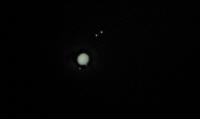
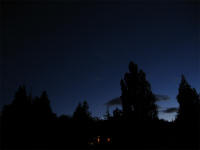 |
The Moon and Jupiter from near Canmore, Alberta - June
2007
Here are some images taken from the deck of our condo in Canmore. One is of
the moon over one of the Three Sisters and looks like the moon is trying to
find a landing spot. The other shows Jupiter over the same mountains in the
evening light. If you blow it up three of the moons are evident. They are
from left to right Callisto, Europa and Granymede.
John McDonald |
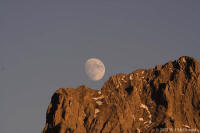
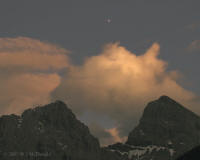
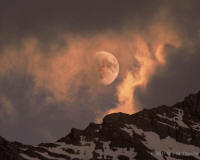 |
Venus-Saturn Conjunction - June 24, 2007
The other day David Lee mentioned the upcoming conjunction of Venus and
Saturn. I actually had stumbled upon this awhile back while playing with my
Sky program when working on a "Top 10 Planetary Nebula List" for the Amastro
group. I had just randomly pick June 30th to look at the early summer sky,
and there they were.
Sunday evening I began my pursuit of witnessing and documenting this
progression, by loading up my truck and driving my gear down to the cricket
pitch in Metchosin. This location gives me the best and most scenic view to
the west, for my area. When I arrived shortly after 2200hrs the scene was
beautiful. There was the blackened silhouette of Mount Blinkhorn against the
darkening blue sky with the glaringly bright Venus hanging in the sky above
it. Four degrees off to the east was the easily visible but much fainter
Saturn.
I had planned on doing a series of sketches but with the not very dark sky
and lack of a prominent star field in that area they will be far from
spectacular. In my opinion this will best be witnessed as a naked eye event.
The sketch that I did has the two planets at opposite sides of two of the
widest FOV that I can get with my 6-inch dob. This would place them at just
over four degrees apart. I had forgotten the 2-inch diagonal for my 80mm
refractor or I should have been able to squeeze them both in the same FOV.
Last night I remembered the diagonal but forgot to bring along a clear view
to the west. Around 2130hrs I managed a short view of the pair with the
refractor though a fleetingly short spelled clear patch. They fit just
nicely within the approximately 4.5 degree FOV at 13 X. Clouds then
completely blanketed the western sky. The view to the southeast remained
relatively clear so I decided to stay for a while. To the sounds of the
Killdeer as they flew about me I actually had the best views of Jupiter that
I've had so far this year.
Shortly before 2300hrs, prospects didn't look good, so I started to pack up.
I was about to throw my dob into the back of my truck when I looked up to
see Venus, blazing like a beacon just about to set into the top of Mount
Blinkhorn. I quickly threw the wide field eyepiece back into the scope and
was greeted by the most remarkable view. It was just like out of a Christmas
card. There was this glowing white crescent perched at the very tip of a
tall fir tree. (OK, so with the dob view it was actually hanging off the
bottom of an upside-down tree, but you know what I mean) With the addition
of the diffraction spikes I was awestruck. A short swing to the east
revealed Saturn. Between the two was a probably around 8th magnitude rather
orange star. I recognized it from the night before. I could clearly see that
Venus had moved towards this star a distance of about halfway from where it
was the night before. Three markings on a page, I guess you can call that a
sketch. Bill Weir |
| International Space Station & Atlantis space shuttle -
June 19, 2007
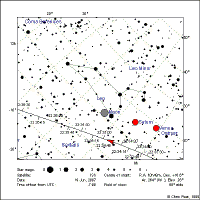
DONT MISS THIS !!
There MAY BE (?) a dual fly by tonight of the Shuttle Atlantis followed by
the ISS (22:37) If you have ever seen one of these duets (it like astro
ballet )it is absolutly mind boggling ! It really gives you a sense of some
one being up in space !p.s. Last nights "ISS fly by" from my home went
Through the Moon AND Saturn. It was a sight I will never forget.
Blair Pellatt
Thanks for the heads up on this -it was a great sight ! - haven't seen
this before. Chuck F.
Amongst a decent sized group of people viewing the ISS and Shuttle pass was
a blast. The night sky viewing with the home schoolers out in Metchosin was
perfect in my estimation. Venus, Saturn and the Moon with Regulus showed
themselves well. Even managed to throw in a couple of Binaries.
The climax of the evening was the ISS Shuttle flyby. They arose in the west
on cue. It was a beautiful sight. They could easily fit in the FOV of my
80mm refractor fitted with a wide field 40mm eyepiece. I was able to track
them quite easily. I even snapped off a couple of shots of each
individually. I linked them together and then rotated it. I took each shot
at exactly the same point when each entered the FOV so I'm fairly sure this
shows them with the proper separation. In the image the streaked line on the
left is the ISS and the one on the right is the Shuttle. They are heading
east which is to the left.
There is also this second image which was a shorter exposure. It was a small
point of light on the large scale. After cropping and enlarging I ended up
with this blurry image. What do you think, Shuttle or ISS? Not bad for a
hand held point and shoot shot through an ED 80mm.
Bill Weir
The ISS? SHUTTLE? close up is AMAZING !
Its great when these unexpected shots produce results. You never know !
Blair Pellatt
Out on a field in Metchosin as the Sun faded we watched the Moon, Regulus,
Saturn and Venus pop in to view. It was a beautiful setting and just prior
to our viewing of the ISS and Shuttle the sky was covered in feathery
clouds. As a special treat while breaking down my telescope I looked up to
see an amazing fireball just above me (~11:45pm). It almost looked like a
bolt of lightning and I could see it slowing down and breaking up.
David Lee
David, I'm glad you saw the fireball too! It was an amazing night, so many
wonderful things to see, probably a once in a lifetime opportunity. Thank
you, Blaire, for making us aware, and Joe for the chart, although that came
too late for me, but we found it regardless. Elizabeth van Akker
That fireball was really bright, I didn't see it from the begining but
glanced up when I noticed the ground was lit up. Matthew |

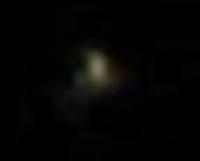
Bill Weir's photos (above)
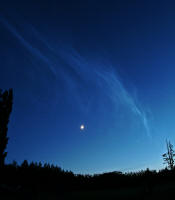
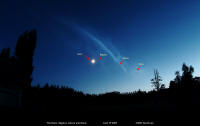
David Lee's photos (above) |
| International Space Station close pass by Saturn & the
Moon - June 18, 2007
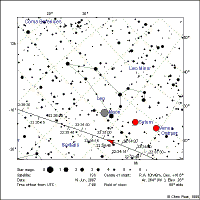 Please
see attached chart of ISS for tonight. Could be a very neat photo
opportunity Blair Pellatt Please
see attached chart of ISS for tonight. Could be a very neat photo
opportunity Blair Pellatt
I observed the pass, but didn't get the photo. I was all setup for it, but I
was so distracted by the awesome sight of the ISS passing through the
conjunction I forgot to click the shutter!
Joe Carr
I got distracted as well. I did click the shutter but was shooting at f/22!
Charles Banville
Dead batteries .. unfortunately no excuse! It was an awesome sight
especially when it came out of the dark side of the Moon.
David Lee
I had setup at Elk Lake for the sunset group of Venus, the Moon and Saturn.
Beautiful night for it. Thank you Blair for your predictions for ISS
and I did see it and even took a picture while it passed through the group.
The image did not show ISS as I had shot the image for 30 seconds at F/32 in
order to hope for a streak through the picture. No luck. I did however get
some nice scenic shots of the lake. Was certainly worth the trip out there.
The Mosquitoes were big enough to almost lift my tripod away, but after it
darkened down they went to bed.
Malcolm Scrimger |
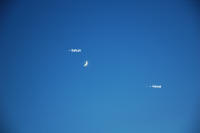
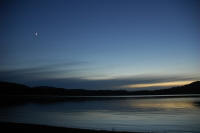
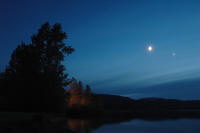
Malcom Scrimger's photos (above) |
| Venus - June 18, 2007 Earlier this evening I was
at the Village Green here in Metchosin, doing some H-Alpha Solar observing
while my son was at Scouts. Occasionally there would be a passer by who had
a look. I was also showing them Venus through my little 80mm refractor. It
was kind of funny because they would say," I don't see it I only see the
Moon." Then I would tell them, that that little crescent was Venus. Then I
would show them how to see it naked eye. I mentioned that I knew that Saturn
would be also visible but I wasn't sure where it was. Duh!
Bill Weir |
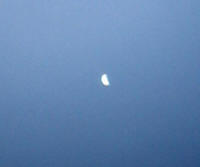 |
|
Alberio - June 16, 2007
I pointed the DSI pro on Albireo to test the colour of that CCD. The result
is not bad, the primary look like white-yellow and the secondary blue. For
sure, there are some limitation with that camera but I still enjoy it and I
will try to push the limit with it...
Michel Michaud |
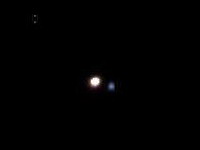 |
| Vesta - June 10 & 13, 2007 Thanks to
Malcolm's fine
article on Vesta, I'd like to contribute a little. I managed (with some
difficulty I might add due to my wooded property) observations of Vesta on
Sunday the 10th and last night the 13th. For doing the observation I was
using my little 80mm refractor at only 18X. The almost 3 degree FOV made
identification easy. The fact that the asteroid is in close proximity to two
6.1 mag stars also helped in making identification easy. The third, 6th mag
dot had clearly moved in the 3 day time span. On Suday the trio formed a
very squat, drawn out V. Last night Vesta was less than a degree directly
north of the eastern of the stars. This created more of a backwards L or
check mark shape. I'd estimate Vesta to be 6th mag because the three dots
appeared almost identical. I say almost because there was a slight golden
appearance to Vesta. The two stars were white. When I increased the
magnification to 54X the golden colour increased.
If anyone is wanting to pursue this more there is a website you might want
to visit this
website, which was created to compile observations around Deep Impact.
It has now resurfaced because of the impending launch of the Dawn Mission
that will send a craft to visit Vesta and Ceres. Observations,
Images/Animations and sketches are welcomed. It is also a source of star
charts for the future. In the grey panel on the left of the page click on
Star Charts and then scroll down. Then just pick a date for a widefield
chart. On the right is a far more detailed 5*X8* chart, for if you are
having trouble picking it out of the field.
Bill Weir
|
M101 - June 11, 2007
Last night after I lost the NGC objects in the clouds and trees, I could see
that M101 was still out of the clouds. Transmission was poor and the
location was in the direction of city light pollution so the results are not
great. Still, I had never imaged this one before so I am pleased to have
something. I am looking forward to trying this one again when I have a
really dark sky.John McDonald |
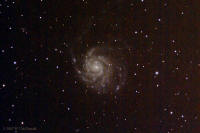 |
| NGC5466 & NGC5053 - June 10, 2007 Last night was
very mixed for sky conditions with some clear periods with some wind and
increasing cloud and lowered transmission in the am. At the suggestion of
Jim Nemec I had a go trying to capture NGC 5053 and 5466. Bill Weir had
warned me that these objects need a good dark sky and and noted that 5053 is
really difficult so I was not expecting great results from my backyard.
Still, I like the challenge of seeing what I can image from my urban
location and it is possible to see both of them in the images (barely in the
case of 5053). I could not really be sure 5053 was in the frames while I was
shooting but I positioned M53 at the edge hoping that would put 5053 in the
frame. It worked although the framing is not the greatest. You should be
able to see 5053 on the left side and M53 is clearly shown at the upper
right.
John McDonald |
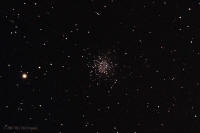
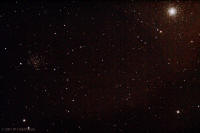 |
| M16 Eagle Nebula - June 8, 2007 Finally, I got a
really clear sky that I was waiting for overnight on Thursday. It was cloudy
early in the evening but cleared as the night progressed and turned into the
best night I have had this year for imaging. The temperature was 12 degrees,
transmission and seeing very good and no wind. I had been wanting to try my
modified Canon 350D on a target with lots of H-alpha nebulosity and the
Eagle Nebula seemed like a good bet. It was up high enough to be above the
trees and in clear air by midnight and the moon did not rise until after
1:30am. I am quite pleased with the result and especially the amount of
nebulosity that shows up in and around the core of this nebula. I think the
image is a keeper. John McDonald |
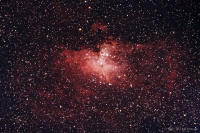 |
| M13 Hercules Cluster & M92 - June 7/8, 2007 While
I was waiting for the Eagle Nebula to get high enough on Thursday night I
spent some time on clusters to get good focus. I ended up taking some frames
of M13 and M92 and the attached shows what resulted. The one of the Hercules
Cluster (M13) goes deeper than I had managed before and as a result it shows
more stars. M92 is dimmer and smaller and had less exposure but still came
out fairly well.
John McDonald
|
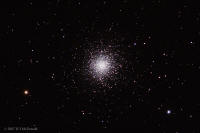
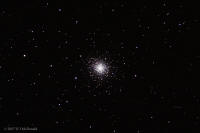 |
| The Sun - Sunspot 0960 - June 2, 2007 I was
feeling pretty lazy today and doing my best to avoid yard work. I had heard
there was a pretty active region moving onto the face of the Sun. It was the
excuse I was looking for to kill a little time. Around 1600hrs I took out my
Zenithstar 80 with the old 0.5A Daystar H-Alpha filter and had a look. A
very large active area with several prominent dark spots was visible close
to the following edge. A large looping prominence was also noted almost
directly opposite on the preceding edge. No other proms were noted.
I then took out my 6" dob with a full aperture white light filter. Now I
know H-Alpha can be pretty exciting but under white light this new Sunspot,
0960 really showed what it is made of. The complexity of the region was
fabulous. I did a sketch of both views. The full surface view in white light
is at 50X and the enlargement at 100X. The H-Alpha is at 56X and 113X. I was
using my 8-24mm Nagler zoom as the eyepiece. It makes it so easy to find the
sweet spots for magnification. Holding the white light filter up to my face
I could just make out the presence of the Sunspot naked eye.
Bill Weir |
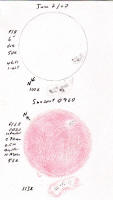 |
| The Moon - Maginus crater & ray - May 25, 2007
Seeing as things were boring on the Sun I decided to do some day time Lunar
observing and this was where I had one of those light bulb going on moments.
Down close to the south polar region of the Moon is a fair sized crater
named Maginus. In it I could make out a nice Sunrise crater ray going on. In
fact, I stumbled across this ray before, a little over a year ago. I also
saw it when I was in Costa Rica just this last March. Now this is where it
gets interesting, or at least it is to me. This past March it was also seen
the day after the X (which I didn't see due to rain) happened. When I first
saw this ray it was on May 6/06. I don't know if the X appeared the day
before that date, but I do know it happened 2 months earlier on Mar 6/06
because I have a photo that I took. It's also when I did that progression
map. The X happens in 2 month cycles so I'm thinking that it probably
happened on the May date. Now stay with me, because I'm finally getting to
my point.
Do you think this Sun rise ray happens every month or is it only on the
cycle of when the libration is favorable to show the X? I guess in a month
I'll know, if the sky cooperates. I'm attaching a not very good shot that I
took of the ray in Maginus. The seeing was awful.
Bill Weir |
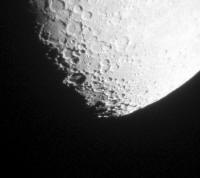 |
| M27 Dumbell Nebula - 2006 & May 24, 2007 I have
been putting together the results of three sessions on M27 and the attached
is the result. Two of the sessions were from last July at Observatory Hill
using a Pentax on the Williams Optics 105mm and the third was last Thursday
at Cattle point using a modified Canon 350D. I only managed to get 17 light
frames of 58s each with the Canon and the transparency was bad but even so,
I got quite a bit of color, especially some nice reds from H alpha light.
The Pentax sessions had a total of 138 30s light frames and gave a more
detail as a result of the longer exposure.
John McDonald |
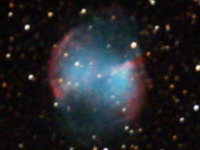 |
| Moon - Plato crater - May 24, 2007 Used a Nikon
D80 dSLR prime focus through a Vixen 4" apo refractor with a 2.5x Powermate.
John Adlington |
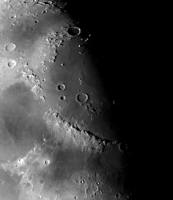 |
| The Lunar "X" Feature - May 23, 2007 Used a Nikon
D80 dSLR prime focus through a Vixen 4" apo refractor with a 2.5x Powermate.
John Adlington |
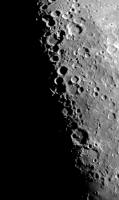 |
| The Lunar "X" Feature - May 23/07 11:44pm I have
observed the Lunar "X" feature several times now, however this event
produced the brightest "X" by far. Here is an image I took of this
feature through my TV-76 a-focally using a 2.5x Powermate and my Canon 30D.
Joe Carr |
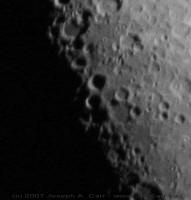 |
| The Lunar "X" Feature - May 23, 2007 10:00pm-11:00pm
I took these two shots between 2200 and 2300hrs May 23/07. In the complete
Moon shot the X is really tiny and just barely visible but what is also in
the shot is the 3.9 mag star rho Leo, (the forward sticking hind foot of
Leo). The Moon skimmed just south of it. That shot was taken through my 6"
dob (I rotated the image for realism) hand holding my wife's point and shoot
to a 22mm eyepiece. The larger cropped image was through a 12mm eyepiece.
Bill Weir |
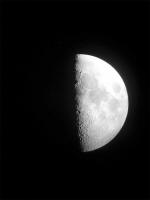
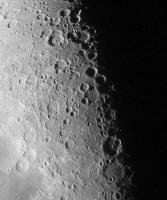 |
| M5 & M10 Globular Clusters - May 22, 2007 In the
bits of clear air I had a go at M5 and M10 last night from my back yard. I
am fascinated with globular clusters because of their age and the puzzle of
how they formed and have lasted so long. I am pretty happy with the image of
M5. M10 could use more exposure but I ran out of clear sky.
John McDonald |
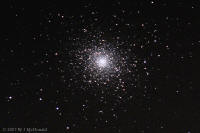
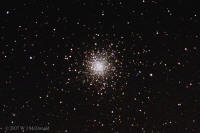 |
| Venus, Saturn, Moon, double stars - May 22, 2007
May 22nd was the first night during the week that the CU was open for the
public until 11:00pm. My price per view for my new equipment was weighing on
me so off I went to the Hill. The skies were iffy but I took a chance to see
many favourite objects.
Early in the evening I had a close look at a crescent shaped Venus, moved on
to a nice view of Saturn and finally to the Moon. The seeing was only fair
but I was happy with clear glimpses of the planets and lunar craters.
As for double stars I had look at the double in Polaris, hard to see with
the thin veil of clouds but visible. The heads of the Twins were visible
just above the 16" telescope dome so I had a look at the double of Castor. I
noticed Leo in the vicinity of the Moon so I acquired a favourite double in
the neck of the Lion, Algieba. The stars were very bloaty indicative of the
seeing but still satisfying.
I can't wait for better skies :-)
David Lee |
| Moon-Venus Conjunction - May 19, 2007
Jim Cliffe got a lovely image of the conjunction earlier this evening.
The view from the parking lot at the CU was also nice tonight at 10:20PM
when I took this image. Clouds everywhere except for the Moon and Venus.
Pretty lucky!
John McDonald |
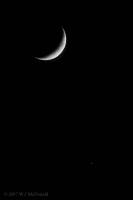 |
| Moon-Venus Conjunction - May 19, 2007 Some
success tonight. Had a few folks looking, and had some nice views of the
Moon/Venus and Saturn for them. The clouds didn't help, but there were a few
breaks. Here's how it looked from Clover Point with my Olympus E-500 &
150mm. Jim Cliffe |
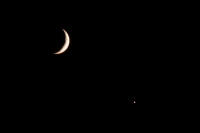 |
| Moon-Venus Conjunction - May 19, 2007 This
was taken from where I live on Mt Tolmie around 20:25 tonight.
Telescope: Antares 102mm, f5
Camera: Nikon D50 modified, 1/200, ISO 200.
Guy Walton |
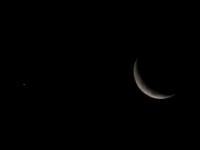 |
| Comet Lovejoy C/2007 E2 and NGC 6015 - May 19, 2007
I really do need to stop looking out before going to bed. I did this around
0015hrs, so 25.25hrs after doing the sketch the evening before. The comet
had moved so much that I needed to use my 40mm eyepiece in my 6" dob to get
the entire view within one FOV. I didn't feel like doing one of my linked
FOV sketches as they take a bit longer to do. The FOV given with this combo
is approximately 2 degrees.
The previous night the comet was approx half way between the brightest star
just left of centre in this sketch and the galaxy at the far left. The
bright star in John McDonald's and
Charles Banville's images is
the one halfway between the brightest star and the galaxy. [John's]
calculations say the comet moved approx
64.4 arcmin. My sketch suggests you could add a bit of that +10% to the
calculations. Bill Weir |
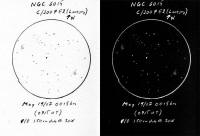 |
| Comet Lovejoy C/2007 E2 and NGC 6015 - May 18, 2007
This picture of comet Lovejoy and NGC 6015 was taken from John McDonald's
backyard. Interestingly, I was reading from Wikipedia that comet Lovejoy was
discovered using a Canon 350D DSLR!
Charles Banville |
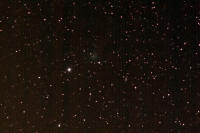 |
| Comet Lovejoy C/2007 E2 and NGC 6015 - May 18, 2007
I had wanted to use the same sized scope to do the repeat observation for
consistency of image scale but I didn't. I was tired from the evening before
and the thought of setting up then taking down my 12.5" truss was more than
I could take so I just set out my 6" dob. The comet had moved a great deal
in 24hrs. At the point of the sketch it had moved to about 0.3 of a degree
from NGC 6015. To give a bit of a perspective, there is a star that I drew
in the first sketch that lies to the right, just outside of the rings
defining the FOV. This is the star that is now dead centre in the second
sketch. Bill Weir |
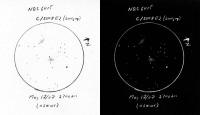 |
| Comet Lovejoy C/2007 E2 and NGC 6015 - May 17, 2007
Well it's crude and could use a bit of tidying up but that will have to wait
until tomorrow. This is how I saw this conjunction tonight as viewed through
my 12.5" dob. I could actually just fit both objects within the single FOV
of my 17mm Nagler. That puts them at approximately 0.88 degrees apart. I had
to stop sketching due to a contrail. I hope someone managed to image this
tonight, it looked very cool. Coincidentally it was exactly a year ago, that
fragmented comet Schwassmann-Wachmann was making its dramatic fly by of M 13
and M57.
Bill Weir |
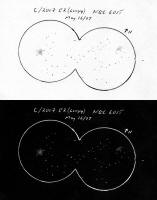 |
|
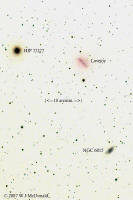 Comet Lovejoy C/2007 E2 and NGC 6015 - May 17, 2007 Comet Lovejoy C/2007 E2 and NGC 6015 - May 17, 2007
After sending out my first attempt at Comet Lovejoy, I thought it might be
fun to measure the angular velocity of the comet from its track on my image.
I also had several more light frames from initial shots when I was adjusting
the scope to get the frame set. Since, I could not really see the comet, I
had spent some time checking my pointing as best I could. It turned out that
all of my frames had the comet in them and I was able to use them all to get
a bit longer track and less noise. I also took some more dark frames to
reduce noise from that source and put more care into the processing. The
result is less noisy and the track is longer (see attached). The exposures
covered the period from 10:57PM to 12:03AM PDT and the track measures 2.80
arcmin (+/- 10%). so the comet was moving at a rate of 2.55 arcmin/hr (+/-
10%). John McDonald |
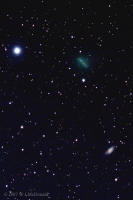 |
| M104, Sombrero Galaxy - May 4 & 17, 2007 This
image is a combination of 38 images (30 sec, ISO 3200) acquired over two
evenings from John McDonald's back yard
using my Meade LX200R 8" operating at f/10 with a non-modified Canon 30D at
prime focus. My image certainly isn't as deep as John's, so perhaps these
modified cameras just "see" better generally, despite the configuration
differences between our two setups.
Joe Carr |
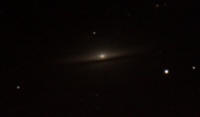 |
| M104, Sombrero Galaxy - May 17, 2007 After
capturing comet Lovejoy last evening, M104 was well situated for imaging and
the skies got fairly clear as well. There was still quite a bit of sky glow
so I decided to use ISO 400 with 58 sec exposures. I am attaching a full
frame wide field image and the cropped version.
John McDonald |
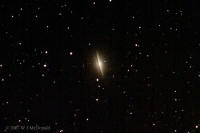 |
| Antares and Rho Ophiuchi Nebulae - May 10, 2007
This is the best of two attempts at imaging the Antares and Rho Ophiuchi
Nebulae. On Monday night I set up at Cattle Point but thin clouds quickly
moved in and disrupted my session. I had another go at it on Wednesday night
from the same location. I was hoping for more details and colours but
Antares doesn't rise higher than 15 degrees above the horizon.
Charles Banville |
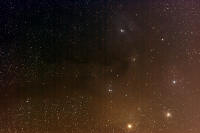 |
| NGC 7000, North America Nebula - May 9/10, 2007
Last night after the RASC meeting, Charles suggested we go to Cattle Point
and stay late as it looked like a good night. As the night progressed some
of the objects that are rich in H-alpha came up giving me a chance to try my
recently acquired 350D camera. This is one with a modified filter to pass
H-alpha light. I tried the North American Nebula and got the attached
result. The modified camera appears to be quite sensitive overall and
especially good in the red as expected.
By the way, it was a long night as I did not get to bed until 3:30am. How
does it go again "..........light years to go before I sleep..."
John McDonald |
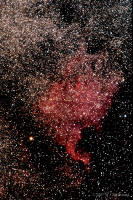 |
| Upper tangent arc & Sun Halo - Apr 29, 2007 The Sun halo was
spectacular. I took the opportunity of using my scope
to apply a little art to the situation.
More info on
Tangent
Arcs. Bill Weir |
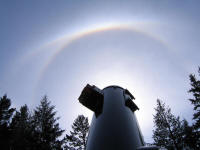 |
| Sunspot 953 - Apr 29, 2007 We are having a very
interesting development with the sun. Sunspot 953 is putting on quite a show
and there are some very nice filaments.
Blair Pellatt |
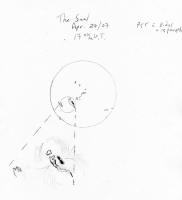 |
| Sunspot 953 - Apr 29, 2007 ISO
800 @ 1/800
Bruno Quenneville |
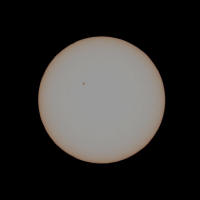 |
| Sun Halo - Apr 29, 2007 ISO 100
@ 1/800 full auto, untouche
Bruno Quenneville |
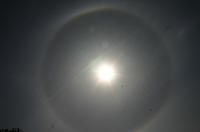 |
| M64, the Black Eye Galaxy - April 14, 2007 M51,
the Whirlpool Galaxy - April 15, 2007
Here are some more images from Saturday night in my backyard. While
Charles was shooting his wonderful ultra deep field of the Coma region, I
focused on two galaxies, M51, the Whirlpool and M64, the Black Eye. I did
M64 first and planned to stop as the clouds kept obscuring the target but it
got better after midnight so I had a go with M51 until 2:30AM. I'm glad I
did as there have been few nights as good recently.
John McDonald |
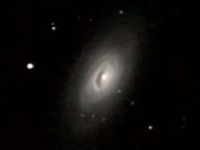
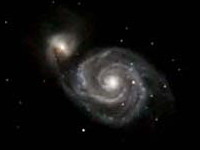 |
| The Virgo Cluster of Galaxies - 14 April 2007
Here's my version of the poor man's Hubble ultra deep field. After making my
way to John's backyard last night, I aimed my 200mm lens at the
constellations Virgo and Coma Berenices. Unlike the Hubble ultra deep field
I couldn't afford to keep the shutter open for days on. Still I was able to
expose for about 40 minutes and got a picture that reveals dozens of
galaxies. Notice the Markarian's Chain and the Siamese Twins. The field is
approximately 6.4 x 4.2 degrees and north is up.
Charles Banville |
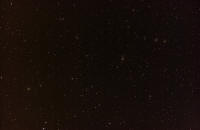
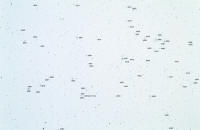 |
| Venus and M45 Pleiades - April 14, 2007 Charles
and I met in my backyard last night to do some imaging and Joe dropped in as
well. It was a strange night with some good clear periods followed by fast
and slow moving clouds nearly totally obscuring the sky at times. I tried
imaging Venus and Pleiades first and the attached are some of the results.
John McDonald |
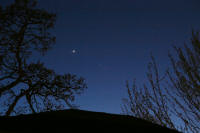
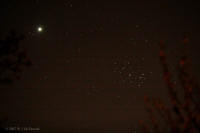 |
| Saturn - April 11, 2007 It is tough to find a hole
these days but I managed to get some clear air for a while last night. It
was quite moist but the seeing was not bad and I got my personal best image
of Saturn before it socked in at 2AM. I like the color which is just as it
came out of the camera.
John McDonald |
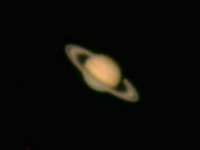 |
| ASTEROID 2006 VV2 - 31 March 2007 Thanks to a
200mm camera lens, John McDonald's go-to capabilities, and a bit of luck I was
successful in imaging 2006 VV2. Here is the result of 24 stacked (and
cropped) images showing asteroid 2006 VV2.
Charles Banville |
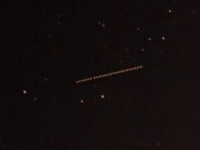 |
|
Werner
"X" feature on the Moon - Mar 26, 2007 approx 1am PDT
Michel Michaud took his first image using a Meade LPI webcam and his 114
Celestron scope. This phenomena was predicted by Dave Chapman, a Halifax
RASC member. Dave's prediction was for 10:30pm PDT, however Michel assures
us he took this image around 1am - so the "X" feature was obviously visible
much later than predicted. |
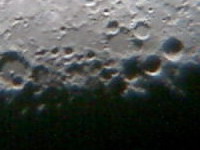 |
| IC443 in Gemini - March 17, 2007 Two sets of
images taken March 17 & 18
RGB 15 minutes each using an AP 155mm at F5.25
Images combined using RegiStar, with final processing in Photoshop Elements
Les Disher |
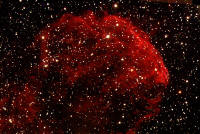 |
| M83 - Southern Pinwheel Galaxy - March 17, 2007 I
took this image on Saturday, March 17 from latitude 37 degrees 48 minutes,
longitude 119 degrees 04 minutes near June Lake, California, in the eastern
Sierras, so I had the advantage of about 12 extra degrees of latitude.
Exposures were RGB 15 minutes each using a 155mm AP at F5.25
Final processing was one in Photoshop elements.
Les Disher |
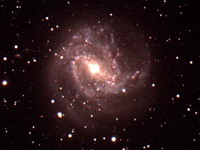 |
| Leo Triplet of galaxies M65, M66 and NGC 3628 - Mar 21,
2007 Last evening the usual clouds were missing and I took the
opportunity to do some imaging from my backyard. The transparency was not
great and there was some wind at times but it was better than most of the
recent nights.
John McDonald |
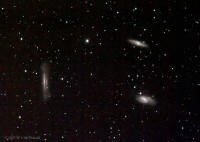 |
| Saturn - Feb 26, 2007 9:15pm PST
Astronomy Caf� has been
rained out or clouded out for so long, we can't remember the last time we
actually did some observing on Monday night. This evening presented us
with mostly clear skies - an opportunity we simply couldn't pass up. I
decided to concentrate on imaging Saturn, since this shallower ring
orientation is something new for me. Both the planetary shadow on the
rings and the rings' shadow on the planet are visible, as well as a
mid-latitude band and a polar region.
Joe Carr |
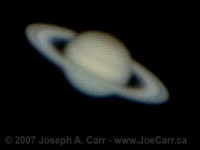 |
| Venus & Mercury - Feb 1, 2007 This is the best
shot out of a dozen I took from Mt. Tolmie.
Malcolm Scrimger |
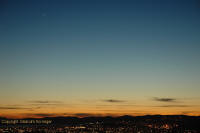 |
| The Horsehead Nebula-B33, The Flame Nebula-NGC 2024, IC
434, M78 - 26 January 2007 - Last Wednesday, I imaged the Horsehead
Nebula from John McDonald's backyard using a new Canon 200mm f/2.8 lens.
Unfortunately, the use of a UV filter on the lens created ghost images and
ruined my picture. So on Friday night I attempted to capture the same
target, without any filter, from the DAO. Success at last! No artifacts are
visible in this picture. On the other hand, the version of my picture taken
from John's location seems less affected by light pollution. Notice M78 in
the frame. Charles Banville |
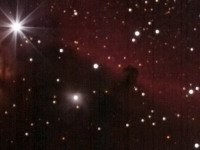 |
| M81, M82, NCG3077 - Jan 11, 2007 - It was
pretty crazy to go up on the hill on such a cold night but on Jan. 11
Charles and I had to do it as we were suffering from clear sky deprivation.
The sky was not as dark from the lower parking lot as we would have liked
and the transparency was not wonderful but it was the best night we had seen
for some time. Temperature was -4deg C with a nasty wind chill. I
concentrated on testing my new Canon Camera on M81/82 and the attached
images are the result. John McDonald
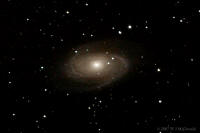
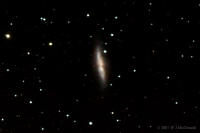 |
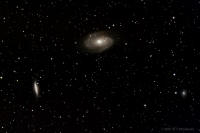
|
| M45, The Pleiades - 11 January 2007 John McDonald
and I went to the DAO on Thursday night. I set up in the lower parking lot
which in retrospect was probably not the best decision due to the city
lights. Here's my image of the Seven Sisters.
Charles Banville |
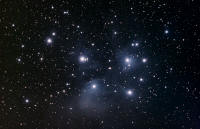 |
| The Orion Nebula - M42, M43, NGC 1977, and NGC 1981 - 11
January 2007 Here is my picture of the Orion Nebula taken on Thursday
night from the DAO. I meant to take short exposures in order to image the
trapezium but I forgot. As a result the core is overexposed. Colour balance
is always challenging with my Canon 20Da and I hope that my choice of colour
temperature is pleasing.
Charles Banville |
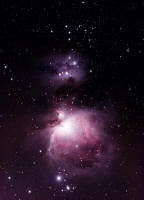 |
| Comet
McNaught C2006 P1 - Jan 11, 2007 I raced around the Western
Communities to find the highest vanatage point out that way and still be
within 1/2 hr from home. I eventually ended up un a dead end street over
looking the Walmart parking lot and the Can West Mall (or what ever it's
called now). The street was packed with cars as beside me was a small hill
that a couple of dozen kids and their parents were using to tobogan into the
parking lot.
By 1620 hrs I had located the Comet with my 10X50 Binoculars then got it in
the sight of my little 80mm refractor. Even at 13X and a better that 4
degree FOV with the refractor the tail streamed out of the FOV. It took a
while but I managed to coax the first kid over to have a look. It wasn't
long before I was surrounded by children and adults alike and we had a great
old time. We chatted, passed the binoculars around, took turns looking in
the scope and just generally stared off to the West in amazement as the
Comet brightened in the sky. Bill Weir |
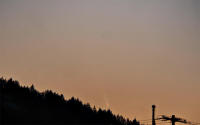 |
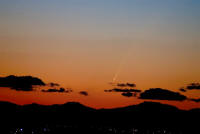 Comet
McNaught C2006 P1 - Jan 11, 2007 Comet
McNaught C2006 P1 - Jan 11, 2007Here are two images of Comet McNaught
taken from Mount Tolmie. The first is a combination of six images in Images
Plus and the second is one image. All images were exposed at 1/5 th second
at ISO 250 with my new Nikon D80 and a Nikkor 70-300mm lens at full
telephoto.
Burrr!!!!! Was it ever cold up there!
Guy Walton |
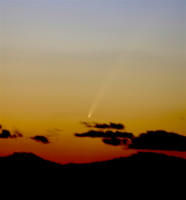 |
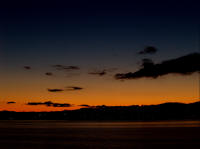 Comet
McNaught C2006 P1 - Jan 11, 2007 Comet
McNaught C2006 P1 - Jan 11, 2007Gearing up this morning paid off. I went straight from work at 1630 to the Duntz
Head viewpoint and set up. What a lovely evening! It would have been worth it
even without the comet. But I agree with Guy. It was very cold.
Here are my first two processed images. The first is just the comet, slightly
cropped from full frame, and the second is a wider view with Venus and McNaught.
There's more detail in the tail, and I'll have to work to tease it out.
Equipment for these was my Olympus E-500 with a Zuiko 45-150 zoom. Being mounted
on a steady tripod, I took advantage of a smaller aperture to ensure a good
focus and hitting the resolution "sweet spot".
Jim Cliffe
|
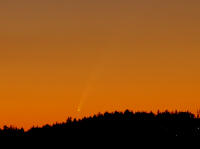 |
| Comet
McNaught C2006 P1 - Jan 11, 2007 5:42pm PST This image is taken from my back porch, which looks westward where the Sun had just set. I scanned the western horizon with my 9x63 binoculars, and there it was - Comet McNaught! When I looked again without the binoculars, it was an easy target. The comet has a very bright core, and a super long and broad tail.
Joe Carr
|
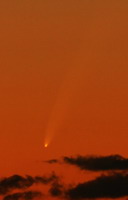 |
| Comet
McNaught C2006 P1 - Jan 11, 2007 Wow, it is a beautiful comet. I went
to Moss Rock at sundown today and got several images of the comet. Here is a
sample. John McDonald |
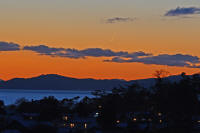 |
| Comet
McNaught C2006 P1 - Jan 11, 2007 Saxe Point turned out to be great. Attached are some images from tonight. Ron
was pretty impressed for the first time since I've been dragging him out to look
at the stars...:)
Paula Brown |
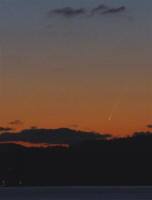 |
| Comet
McNaught C2006 P1 - Jan 11, 2007
Mike Jackson's Picasa Album |
 |